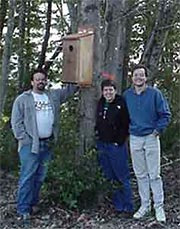Nest Box Project
(Last Revised 2/2004)
Artificial nest structures have been used worldwide with great success. Given the lack of information on cavity nesting birds in Mendocino County, we have developed an exploratory project to learn about existing bird populations and their breeding biology in old growth and second growth stands. We are currently developing a nest box study to compare artificial cavity use in old growth and adjacent second growth stands. The following questions will be addressed in the nest box study:
- Is there a difference in available snags and cavities between old growth and second growth stands?
- Is there a difference in nest box use between old growth and second growth stands?
- Do secondary cavity-nesters use nest boxes more frequently in second growth than old growth stands?
The aim of this study is to determine if the abundance of cavities and/or cavity-nesting birds in second growth stands differs from old growth stands.
 This project is not a mitigation tool to "replace" snags, but rather a way to examine snag and cavity tree use in two different. Since birds do not use the same sized cavities, nor the same sized cavity holes, artificial nests were built in two sizes: kestrel-sized and bluebird-sized. These artificial nests will attract different species. The larger kestrel-sized boxes will likely attract small raptors (e.g. American Kestrels, small owls) and large woodpeckers (e.g. Pileated Woodpeckers, Red-shafted Flickers). The smaller bluebird-sized boxes should attract smaller species such as chickadees and nuthatches.
This project is not a mitigation tool to "replace" snags, but rather a way to examine snag and cavity tree use in two different. Since birds do not use the same sized cavities, nor the same sized cavity holes, artificial nests were built in two sizes: kestrel-sized and bluebird-sized. These artificial nests will attract different species. The larger kestrel-sized boxes will likely attract small raptors (e.g. American Kestrels, small owls) and large woodpeckers (e.g. Pileated Woodpeckers, Red-shafted Flickers). The smaller bluebird-sized boxes should attract smaller species such as chickadees and nuthatches.
During the study, we will monitor nest boxes on a monthly basis unless signs of nesting activity are detected. We will identify the birds nesting in the box and determine reproduction. These data will include species, clutch size, and the number of nestlings that fledge.
We anticipate nest boxes will be placed in an old growth and adjacent second growth stand in the fall of 2004 with data collection beginning in the spring of 2005.